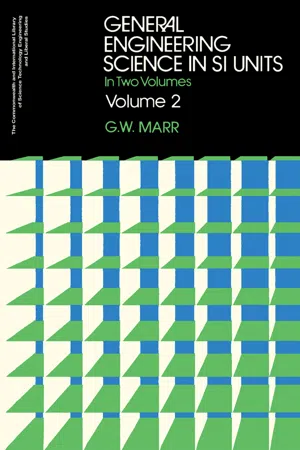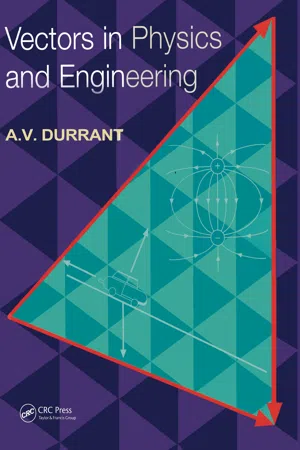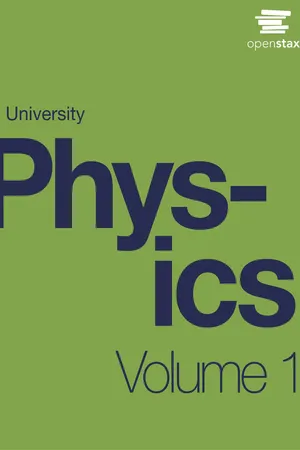Mathematics
Acceleration and Time
Acceleration is the rate of change of velocity over time. It is a vector quantity, meaning it has both magnitude and direction. Time is a fundamental concept in mathematics that measures the duration of events and the intervals between them. In the context of acceleration, time is crucial for understanding how velocity changes over a specific period.
Written by Perlego with AI-assistance
Related key terms
1 of 5
11 Key excerpts on "Acceleration and Time"
- eBook - PDF
General Engineering Science in SI Units
In Two Volumes
- G. W. Marr, N. Hiller(Authors)
- 2016(Publication Date)
- Pergamon(Publisher)
The definition of acceleration indicates that a unit of acceler-ation is obtained from the ratio u ^uoft^me y · T h u s i n t h e SI s y s t e m the basic unit is the metre s ^ n s d econd or metre per second per second, usually abbreviated to m/s 2 . EXAMPLE. A cyclist, starting from rest, attains a speed of 18 km/h in 55 s, while travelling in a straight line. Calculate his aver-age acceleration. Change in velocity = 18 — 0 = 18 km/h 18X10 3 , = -T6ÖÖ-m/s = 5 m/s Time required for change = 55 s Λ average acceleration = ^ m/s 2 ^ 0091 m/s 2 EXAMPLE. A train pulls out of a station with a uniform accelera-tion of 15 cm/s 2 . How long will it take to reach a speed of 54 km/h? Change in speed = 54 — 0 km/h = 54 km/h 54X10 3 3 600 = 15 m/s m/s A Λ . change in speed Acceleration = %— Λ change in speed • · * im e required = acceleration 15 m/s 15XlO-2 m/s 2 100 s 36 VELOCITY AND ACCELERATION 2.4. Distance-time Graphs A distance-time graph is a graph in which the distance travelled in a given time is plotted as ordinate, the corresponding time being plotted as abscissa. For non-uniform motion the graph will be a curve, such as that shown in Fig. 2.2. A general idea of the motion can be deduced from such a graph. Over the portion OA of the graph the curve is concave upward; that is, the graph is W QJ tt> E. w m to u c n V) Q 80 70 bO 50 40 30 .20 10 u 10 20 30 40 50 Time, t seconds F I G . 2.2. rising more and more steeply. The distance travelled during any particular time interval within this total period is thus greater than the distance travelled during the preceding equal interval of time. Hence the average velocity is increasing and the motion is therefore accelerated motion. Over the portion AB, the concavity of the curve is downward; the velocity is progressively decreasing and therefore the moving body is decelerating. During the time interval (i 2 — h), the distance travelled is O2—$i), as indicated in Fig. 2.3. The average velocity during this period is 37 - eBook - PDF
- John D. Cutnell, Kenneth W. Johnson, David Young, Shane Stadler(Authors)
- 2021(Publication Date)
- Wiley(Publisher)
It equals the change ∆ → v in the velocity divided by the elapsed time ∆t, the change in the velocity being the final minus the initial velocity; see Equation 2.4. When ∆t becomes infinitesimally small, the average acceleration becomes equal to the instantaneous acceleration → a , as Focus on Concepts 51 indicated in Equation 2.5. Acceleration is the rate at which the veloc- ity is changing. ¯ → a = ∆ → v ___ ∆t (2.4) → a = lim Δt→0 ∆ → v ___ ∆t (2.5) 2.4 Equations of Kinematics for Constant Acceleration/ 2.5 Applications of the Equations of Kinematics The equa- tions of kinematics apply when an object moves with a constant acceleration along a straight line. These equations relate the dis- placement x − x 0 , the acceleration a, the final velocity υ, the initial velocity υ 0 , and the elapsed time t − t 0 . Assuming that x 0 = 0 m at t 0 = 0 s, the equations of kinematics are as shown in Equations 2.4 and 2.7–2.9. υ = υ 0 + at (2.4) x = 1 _ 2 (υ 0 + υ)t (2.7) x = υ 0 t + 1 _ 2 at 2 (2.8) υ 2 = υ 0 2 + 2ax (2.9) 2.6 Freely Falling Bodies In free-fall motion, an object experi- ences negligible air resistance and a constant acceleration due to grav- ity. All objects at the same location above the earth have the same acceleration due to gravity. The acceleration due to gravity is directed toward the center of the earth and has a magnitude of approximately 9.80 m/s 2 near the earth’s surface. 2.7 Graphical Analysis of Velocity and Acceleration The slope of a plot of position versus time for a moving object gives the object’s velocity. The slope of a plot of velocity versus time gives the object’s acceleration. Focus on Concepts Online Time Position A B C QUESTION 8 Section 2.6 Freely Falling Bodies 6. A rocket is sitting on the launch pad. The engines ignite, and the rocket begins to rise straight upward, picking up speed as it goes. At about 1000 m above the ground the engines shut down, but the rocket continues straight upward, losing speed as it goes. - eBook - PDF
General Engineering Science in SI Units
The Commonwealth and International Library: Mechanical Engineering Division
- G. W. Marr, N. Hiller(Authors)
- 2013(Publication Date)
- Pergamon(Publisher)
Section 2 Velocity and Acceleration 2.1. Motion When the position of one body relative to another is continuously changing the bodies are said to be in relative motion. Motion, in fact, is always relative. In very many cases we are concerned with the motion of a body relative to the earth, and in such cases the word relative is generally omitted. We are accustomed to refer-ring simply to the motion of a motor vehicle or aircraft. We may say, for example, that a caj* is travelling at a speed of 30 km/h. When we do so, it must be understood that the speed is relative to the earth. 2.2. Velocity The velocity of a body is the rate at which the body is changing its position. Because direction is involved, velocity is a vector quantity. The magnitude, or numerical value, of a velocity is called the speed. The average speed of a body during a given interval of time IS measured by the ratio total distance^raven.d in given time W h e n a body travels equal distances during equal intervals of time, what-ever the magnitude of the time interval, the body is said to travel with constant speed. A velocity may change because of change in speed, or in the direction of motion or because of a change v in both of these. 32 VELOCITY AND ACCELERATION When a body moves in such a way that its velocity does not change, it is said to move with constant, or uniform, velocity. Hence to move with uniform velocity, a body must travel at constant speed in a straight line. EXAMPLE. A vehicle travels a distance of 840 m in 30 sec. Express its average speed in km/h. Distance travelled = 840 m = 0-84 km. 30 s = ai 0-84 km Time interval = 30s = g§öö h = iiö-h .*. average speed — —j = 100-8 km/h. EXAMPLE. The straight-line distance between two towns, A and B, is 49 km. Town A is due north-west from B. The road distance between the towns is 56 km. A motorist leaves A at 13.20 h and arrives at B at 14.10 h. Calculate (a) his average speed; (b) his average velocity. - eBook - PDF
- John D. Cutnell, Kenneth W. Johnson, David Young, Shane Stadler(Authors)
- 2018(Publication Date)
- Wiley(Publisher)
When ∆t becomes infinitesimally small, the average acceleration becomes equal to the 48 CHAPTER 2 Kinematics in One Dimension instantaneous acceleration a → , as indicated in Equation 2.5. Acceleration is the rate at which the velocity is changing. a → = ∆v → ∆t (2.4) a → = lim ∆ t →0 ∆ v → ∆t (2.5) 2.4 Equations of Kinematics for Constant Acceleration/2.5 Applications of the Equations of Kinematics The equations of kinematics apply when an object moves with a constant acceleration along a straight line. These equa- tions relate the displacement x − x 0 , the acceleration a, the final velocity υ, the initial velocity υ 0 , and the elapsed time t − t 0 . Assuming that x 0 = 0 m at t 0 = 0 s, the equations of kinematics are as shown in Equations 2.4 and 2.7–2.9. υ = υ 0 + at (2.4) x = 1 2 (υ 0 + υ) t (2.7) x = υ 0 t + 1 2 at 2 (2.8) υ 2 = υ 2 0 + 2ax (2.9) 2.6 Freely Falling Bodies In free-fall motion, an object experiences neg- ligible air resistance and a constant acceleration due to gravity. All objects at the same location above the earth have the same acceleration due to gravity. The acceleration due to gravity is directed toward the center of the earth and has a magnitude of approximately 9.80 m/s 2 near the earth’s surface. 2.7 Graphical Analysis of Velocity and Acceleration The slope of a plot of position versus time for a moving object gives the object’s velocity. The slope of a plot of velocity versus time gives the object’s acceleration. Note to Instructors: The numbering of the questions shown here reflects the fact that they are only a representative subset of the total number that are available online. However, all of the questions are available for assignment via WileyPLUS. Section 2.1 Displacement 1. What is the difference between distance and displacement? (a) Distance is a vector, while displacement is not a vector. (b) Displacement is a vector, while distance is not a vector. - eBook - PDF
- John D. Cutnell, Kenneth W. Johnson, David Young, Shane Stadler, Heath Jones, Matthew Collins, John Daicopoulos, Boris Blankleider(Authors)
- 2020(Publication Date)
- Wiley(Publisher)
Specifically, the notion of acceleration emerges when the change in the velocity is combined with the time during which the change occurs. The meaning of average acceleration can be illustrated by considering a plane during take-off. Figure 2.4 focuses attention on how the plane’s velocity changes along the runway. During an elapsed time interval Δt = t − t 0 , the velocity changes from an initial value of v 0 to a final velocity of v. The change Δ v in the plane’s velocity is its final velocity minus its initial velocity, so that Δ v = v- v 0 . The average acceleration a is defined in the following manner, to provide a measure of how much the velocity changes per unit of elapsed time. CHAPTER 2 Kinematics in one dimension 31 FIGURE 2.4 During take-off, the plane accelerates from an initial velocity v 0 to a final velocity v during the time interval Δt = t − t 0 . t 0 v 0 v t – + a Definition of average acceleration Average acceleration = Change in velocity Elapsed time a = v - v 0 t - t 0 = Δ v Δt (2.4) SI unit of average acceleration: metre per second squared (m/s 2 ) The average acceleration a is a vector that points in the same direction as Δ v, the change in the velocity. Following the usual custom, plus and minus signs indicate the two possible directions for the acceleration vector when the motion is along a straight line. We are often interested in an object’s acceleration at a particular instant of time. The instantaneous acceleration a can be defined by analogy with the procedure used in section 2.2 for instantaneous velocity: a = lim Δt→0 Δ v Δt (2.5) Equation 2.5 indicates that the instantaneous acceleration is a limiting case of the average acceleration. When the time interval Δt for measuring the acceleration becomes extremely small (approaching zero in the limit), the average acceleration and the instantaneous acceleration become equal. - eBook - PDF
- John Matolyak, Ajawad Haija(Authors)
- 2013(Publication Date)
- CRC Press(Publisher)
Time is an explicit variable in Equations 2.9 and 2.12. A new equation can be generated from these two equations with no explicit time dependence on it. The time t can be eliminated by substi-tuting for it from Equation 2.9 into Equation 2.12, giving the third equation of motion v v ax o 2 2 = + 2 . (2.13) 36 Essential Physics © 2010 Taylor & Francis Group, LLC Equations 2.3, 2.9, 2.12, and 2.13 offer a complete set of equations that can provide a detailed history of the object’s motion once its initial conditions and acceleration are given. EXAMPLE 2.7 An automobile is moving with a velocity of 20.0 m/s (45.0 mi/h) when its driver suddenly noticed an accident blocking a major part of the highway. He immediately pressed on the brakes and was able to bring his car to a full stop in a distance of 30.0 m. Determine a. The acceleration of the car during this controlled slowing process b. The time that it took the driver to get his car fully stopped from the moment he slammed on the brakes S OLUT ION a. Equation 2.13 is used here since it does not contain time, which remains unknown, but it does contain the acceleration. v v ax o 2 2 2 = + . Substituting for v = 0, v o = 20.0 m/s, and x = 30.0 m, gives 0 (20.0 m/s) 2 a (30.0 m). 2 = + Solving for a gives a = − (4.00 × 10 2 )/60.0 = − 6.67 m/s 2 . b. Now, the acceleration is known; so, to find the time taken to stop the car, use Equation 2.9. v = v o + at. Substituting for the given quantities gives 0 = 20.0 m/s + ( − 6.67 m/s 2 )t. Solving for t yields t = 3.00 s. A NALYSIS 1. The acceleration turned out to be negative. This means that the acceleration is in fact decel-erating the car instead of accelerating it. That is, the change happening to the velocity of the car is from higher to lower velocities, which is what is expected in a case like this. 2. A value of 20.0 m/s (45.0 mi/h) for the initial velocity is considered a reasonable value. - eBook - ePub
- Alan Durrant(Author)
- 2019(Publication Date)
- CRC Press(Publisher)
2 were concerned with vectors that remained constant in time. We now consider vectors that vary in time, i.e. time-dependent vectors. An important application is the study of moving bodies. The position vector of a moving body generally varies in magnitude and direction. The velocity and acceleration vectors may also vary. The acceleration vector is of particular interest because acceleration is produced by forces, as described by Newton’s second law of motion. The velocity and acceleration vectors are obtained from the position vector by the methods of differential calculus. The application of calculus to vectors is introduced in this chapter and is in fact the main theme of the remainder of this book.The study of moving bodies, without regard to the causes of motion, is called kinematics ; while the study of the effects of forces on moving bodies is called dynamics .Sections 3.1 and 3.2 introduce the concept of a vector function of time and show how a vector function can be differentiated from first principles. Rules for differentiating sums and products of vector functions are stated (but not derived) in Section 3.3 . important examples of particle motion such as projectile motion and motion in a circle are considered. The angular velocity vector is introduced in Section 3.4 . The final sections describe applications to relative motion, including the derivation of inertial forces in accelerating and rotating frames of reference.3.1 Introducing Vector Functions
We begin with a brief review of ordinary scalar functions of a single scalar variable in order to establish some notation and definitions.3.1.1 Scalar functions - a review
A scalar function f is defined by a rule and a domain. The rule specifies a unique scalar function value f (x) for each value x of the independent scalar variable. The rule is usually in the form of an equation, such as f (x) = x + 2. The set of values of the independent variable x over which the rule is to be used is called the domain of the function. Thus we have, for example, the scalar function f - Paul Grimshaw, Neil Fowler, Adrian Lees, Adrian Burden(Authors)
- 2007(Publication Date)
- Routledge(Publisher)
Differentiation is a mathematical process that quantifies the change in one variable with respect to another. In this case, displacement and velocity with respect to time. Therefore, differentiation of a displacement–time curve allows the determination of the rate of change of displacement (i.e., the instantaneous velocity). Similarly the differentiation of a velocity–time curve allows the determination of the rate of change of change of velocity (i.e., the instantaneous acceleration).In sport and exercise biomechanics, experimental data consist of a series of discrete data values, so to obtain the instantaneous velocity (or acceleration) it is necessary to use a method of numerical approximation. There are a number of numerical differentiation methods we can use but the simplest (and most frequently used) technique is the finite difference method.Table A5.1 represents the displacement-time data for an athlete during a 100 m sprint race. The displacement from the start at each one second interval is recorded in column two. The true instantaneous velocity of the athlete can never be known but if the time interval was sufficiently small it may be possible to estimate the velocity of the athlete during the race using the average velocity between the known data points. That is, we use the equation A5.1 :where v is the approximated instantaneous velocity, and si and ti are displacement, and times at instant i, and si+1 and ti+1 are the displacement and times at the next data value. For example, between time 0.0 s and 1.0 s the velocity is given by:It is important to note that the velocity value is ascribed to the mid-point between the two displacement values (i.e., for displacement at times 0 s and 1 s the velocity is attributed to 0.5 s). This is because the velocity is assumed to be constant between the two displacement points so it makes sense to pick a point midway between them. Acceleration may be calculated in a similar way and the acceleration value is ascribed to the mid-point between the two velocity values. Thus, end point data are lost when velocity is calculated and that even more data points are lost when acceleration is determined. The calculated velocity and acceleration for the whole race is given in Table A5.1- eBook - ePub
- Hiqmet Kamberaj(Author)
- 2021(Publication Date)
- De Gruyter(Publisher)
As indicated in Fig. 4.3, the direction of Δ v is found by adding the vector − v i (the negative of v i) to the vector v f, because by definition (4.7) Δ v = v f − v i. If the average acceleration of a particle changes during different time intervals, it is useful to define its instantaneous acceleration a. Definition 4.7 (Instantaneous acceleration). The instantaneous acceleration is defined as the limiting value of the ration Δ v / Δ t as Δ t approaches 0: (4.8) a ≡ lim Δ t → 0 Δ v Δ t = d v d t. That is, the instantaneous acceleration is the derivative of the velocity vector with respect to. time. Note that there exist various changes when a particle accelerates. First, the change with time on the magnitude of the velocity vector; that is, the speed may cause the particle to accelerate, similar to the straight-line (one-dimensional) motion. Second, the change with time on the direction of the velocity vector even if its magnitude remains constant, as in curved-path (two-dimensional) motion, can also cause the particle to accelerate. Finally, if both the magnitude and the direction of the velocity vector change with time simultaneously, the particle accelerates. 4.2 Three-dimensional motion with constant acceleration We focus on three-dimensional motion with constant acceleration in both magnitude and direction to derive the kinematic equations. For the three-dimensional motion, the position vector of a particle can be written as (4.9) r = x i + y j + z k where x, y, z, and r are functions of time as the particle moves while i, j and k are constant and unitary vectors, that. is, (4.10) | i | = 1, | j | = 1, | k | = 1. The velocity of a particle can be obtained from its position vector. as (4.11) v = d r d t = d d t (x i + y j + z k) = d x d t i + d y d t j + d z d t k = v x i + v y j + v z k where (4.12) v x = d x d t (4.13) v y = d y d t (4.14) v z = d z d t are the components of the velocity vector v along - eBook - PDF
- William Moebs, Samuel J. Ling, Jeff Sanny(Authors)
- 2016(Publication Date)
- Openstax(Publisher)
• The velocity vector is tangent to the trajectory of the particle. • Displacement r → (t) can be written as a vector sum of the one-dimensional displacements x → (t), y → (t), z → (t) along the x, y, and z directions. • Velocity v → (t) can be written as a vector sum of the one-dimensional velocities v x (t), v y (t), v z (t) along the x, y, and z directions. 196 Chapter 4 | Motion in Two and Three Dimensions This OpenStax book is available for free at http://cnx.org/content/col12031/1.5 • Motion in any given direction is independent of motion in a perpendicular direction. 4.2 Acceleration Vector • In two and three dimensions, the acceleration vector can have an arbitrary direction and does not necessarily point along a given component of the velocity. • The instantaneous acceleration is produced by a change in velocity taken over a very short (infinitesimal) time period. Instantaneous acceleration is a vector in two or three dimensions. It is found by taking the derivative of the velocity function with respect to time. • In three dimensions, acceleration a → (t) can be written as a vector sum of the one-dimensional accelerations a x (t), a y (t), and a z (t) along the x-, y-, and z-axes. • The kinematic equations for constant acceleration can be written as the vector sum of the constant acceleration equations in the x, y, and z directions. 4.3 Projectile Motion • Projectile motion is the motion of an object subject only to the acceleration of gravity, where the acceleration is constant, as near the surface of Earth. • To solve projectile motion problems, we analyze the motion of the projectile in the horizontal and vertical directions using the one-dimensional kinematic equations for x and y. • The time of flight of a projectile launched with initial vertical velocity v 0y on an even surface is given by T tof = 2(v 0 sin θ) g . This equation is valid only when the projectile lands at the same elevation from which it was launched. - eBook - ePub
Doing Physics with Scientific Notebook
A Problem Solving Approach
- Joseph Gallant(Author)
- 2012(Publication Date)
- Wiley(Publisher)
These four equations of motion describe the 1-dimensional motion of an object moving with a constant acceleration. They relate the object’s position and velocity to its constant acceleration and the elapsed time.How far does the car in Example 2.3 travel while it is accelerating?Example 2.5A test drive againSolution.There are several ways to solve this problem. You can use Eq. (2.5d) with v0 = 0 and x0 = 0 and Solve Exact to get an expression for x to find the distance traveled.Then Evaluate the result.Since you know the time, you can also Evaluate Eq. (2.5a) with x0 = 0 and v0 = 0.You can even Evaluate Eq. (2.5b) , taking the average of the initial and final velocities.Again the answers are slightly different because 60 mi/ h is only approximately 26.822 m/ s. All three results are 60.35 m to four significant figures.Signs of the Times
Displacement, velocity, and acceleration can all be positive, negative, or zero. The sign of each tells you something about the motion. A positive displacement means the object’s position is to the right of its starting position. A negative velocity means the object is moving to the left. A zero acceleration means the object’s velocity is not changing.Table 2.1 summarizes the sign information for displacement and velocity for horizontal motion.Table 2.1
If the displacement and velocity have the same sign, the object is moving away from the origin. If they have opposite signs, the object is moving toward the origin.DisplacementVelocity Interpretation Positive Positive To the right, moving right Positive Negative To the right, moving left Negative Positive To the left, moving right Negative Negative To the left, moving left
Index pages curate the most relevant extracts from our library of academic textbooks. They’ve been created using an in-house natural language model (NLM), each adding context and meaning to key research topics.










